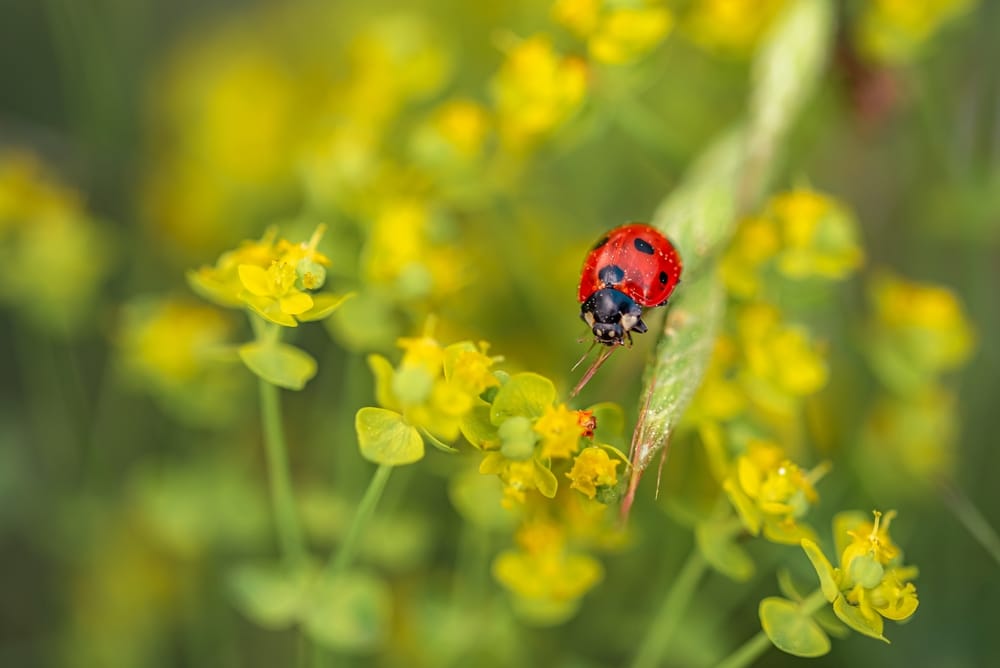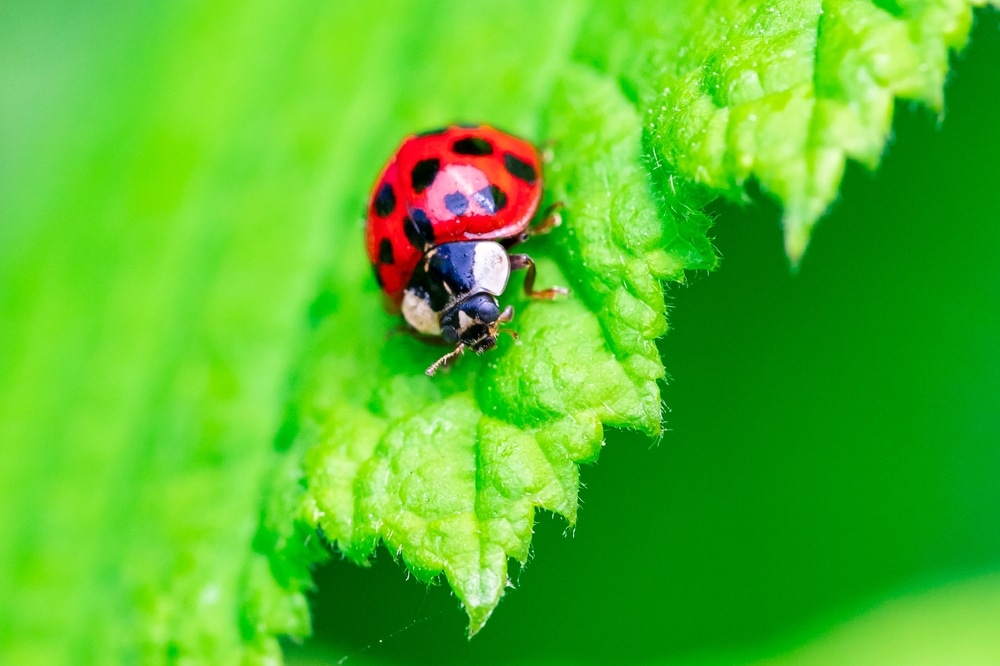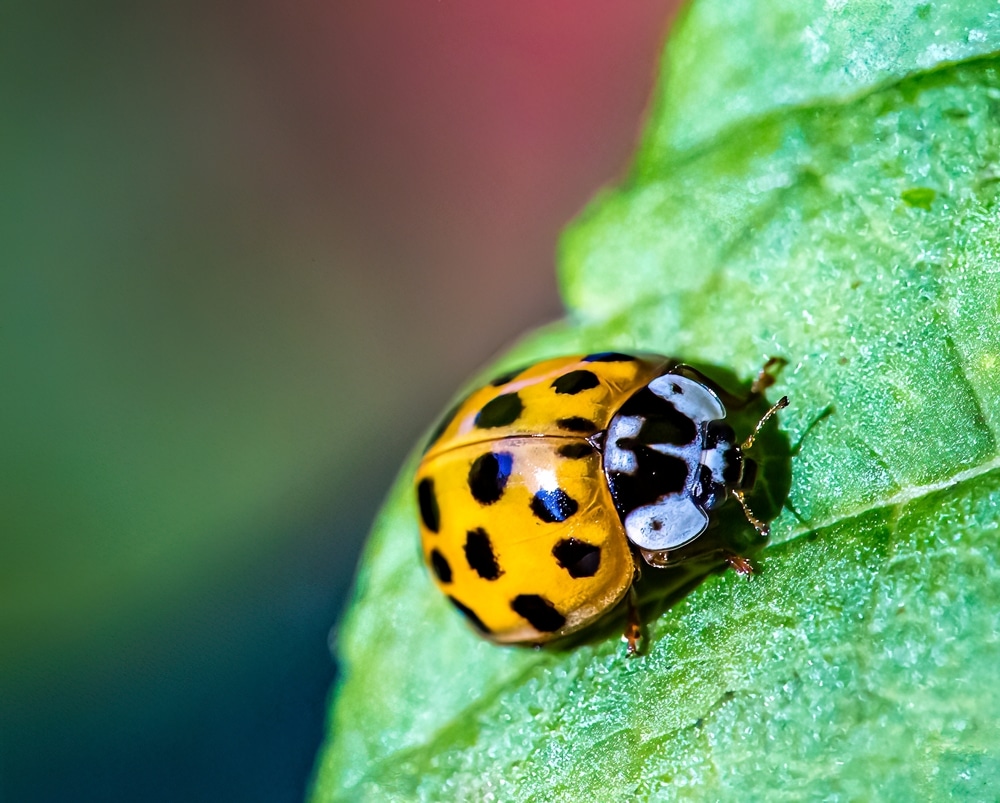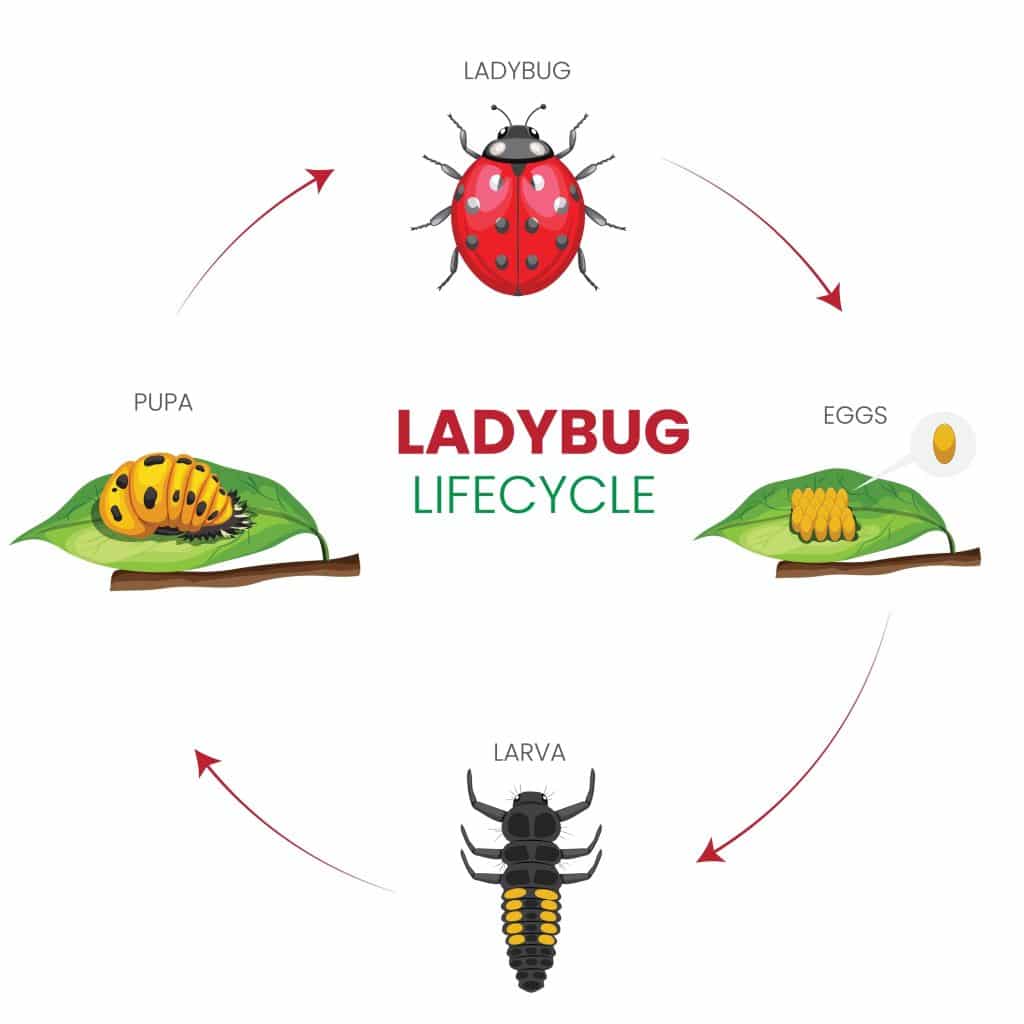As a child, I was always in awe of ladybugs. I would count how many spots each one had and let them crawl all over my fingers and hands. I would dress up for Halloween as a ladybug almost every year! They are a staple in my childhood memories and in the garden space too.
What do ladybugs eat? Well, their favorite snack is aphids but they enjoy a whole lot more too! In this article, we’ll explore everything about ladybugs, including, what do ladybugs eat? how these Nature’s Little Garden Helpers are used in organic gardening, their lifecycle, conservation efforts, and most importantly, how to attract and keep ladybugs in your garden space.
So, let’s explore what we can learn about ladybugs, Nature’s Little Garden Helpers and What Do Ladybugs Eat today.
What Is A Ladybug?
Ladybugs are a variety of small beetles in the family Coccinellidae. More than 6,000 species of ladybugs are distributed globally. In the U.K ladybugs are known as Ladybirds!
Ladybugs are small and red with black spots. This defining characteristic is a defense mechanism called aposematism. This form of deference signifies to predators using bright colors, that the bug is not worth eating. Different color variations are possibly within different species of ladybugs. Colors range from yellow, red and brown with black spots.
There is sexual dimorphism within ladybugs. This means the two sexes look different, with females generally being larger than males.
Ladybug Diet: What Do They Eat?

A ladybug’s favorite meal is aphids. They are able to consume up to 60 aphids a day! Ladybugs are considered carnivorous predators but there are some varieties that are omnivores and eat a variety of food. A ladybug’s prey is primarily insects. Ladybug insect diet includes:
- Aphids
- Scale insects
- Mites
- Whiteflies
- Caterpillars
- Beetle larvae
- Insect eggs
- Nymphs
- And more!
What do ladybugs eat besides aphids? Well, they also love to eat plant matter and more! Some of their favorites are:
- Fruit, such as
- Berries
- Figs
- Nectarines
- Peaches
- Grapes
- Plums
- Nectar
- Pollen
Do Ladybugs Eat Ants?
A commonly asked question is do ladybugs eat ants? The answer is no. Interestingly enough, the opposite is true. Ants will attack and eat ladybugs. They do so to protect aphids.
This is because ants and aphids have formed a mutually beneficial friendship that has developed over a long period of time. In the natural world, this is called a symbiotic relationship.
In the case of aphids and ants, it is a trade of food for protection. Aphids produce a sugar-like sap that ants eat. In return, ants protect the aphids from ladybugs. Ants are known to protect their flock of aphids by attacking and even killing ladybugs!
Why Are Ladybugs Beneficial For Your Garden?

Ladybugs are an iconic garden insect that adds an air of whimsy to the garden space. Having these insects around help in the mitigation of garden pests, like aphids. The ladybug’s role within the ecosystem includes both predator and prey, as they provide food for other insects and birds. By creating a garden space that supports ladybugs, you are creating a biodiverse sanctuary for many beneficial bugs.
Ladybugs are an indicator species of healthy ecosystems. They are also an important pollinator species.
They are used as biological mitigation for aphids, which is great for organic gardening. Some species are bred commercially on ladybug farms. They are sold to organic farmers and play a role in natural pest control. Their prime target is aphids and other sap-sucking insects.
Tips For Using Ladybugs In Your Garden

How Ladybugs Are Used In Organic Gardening
Ladybugs are a form of biological control used in sustainable gardening. They are specifically used in the mitigation of aphid populations. Aphids are considered a major pest for any gardener.
For flower farmers, aphids are particularly annoying, as they are drawn to the prized flower ranunculus. Flower farmers will spend hours picking and blowing aphids off these luxury flowers!
One way that really helps to control aphid populations is by releasing ladybugs. You can even buy commercially sold ladybugs to release in your garden to help control aphid populations.
Here are some of my top tips to help guarantee a higher success rate for ladybugs eating aphids.
Use Row Cover
If not properly contained, ladybugs naturally tend to fly away when released. It is recommended to release ladybugs in a greenhouse and under garden row cover. By having row cover on your plants, it helps to keep ladybugs in place long enough to begin munching on the aphids!
Release Your Ladybugs At Night
Releasing your ladybugs at night also increases munching success rate. Ladybugs don’t typically fly around and eat during the nighttime, so they will rest until the day. Then they will munch away!
Conserving Native Ladybug Populations

Threats
Ladybug populations are in decline due to habitat loss, climate change, and invasive species. Invasive species of other varieties of ladybugs are especially damaging to native species of ladybugs. This is because they will eat other ladybugs and outcompete for other resources.
Conservation Tips
Go Organic
Going organic in the garden is not only helpful to ladybugs, but to all plants and animals. Pesticides kill ladybugs so by spraying your plants, you are harming these beneficial insects. Creating a sustainable garden is an easy and impactful way to help ladybug populations.
Plant Native Plants
Ladybugs love native plants. By planting native plants you attract a variety of insects for the ladybugs to eat. Additionally, you are creating biodiverse landscapes that benefit all types of birds and beneficial insects.
How To Attract And Keep Ladybugs In Your Garden

There are a couple of ways to create beneficial ladybug habitat. First is providing a food source and second is providing an overwintering site.
Plants That Attract Ladybugs
Planting native plants and herbs draws in insects for ladybugs to eat. It also provides nesting sites for females to lay their eggs. Some of the plants I recommend are:
- Yarrow
- Feverfew
- Marigold
- Calendula
- Sunflower
- Sweet alyssum
- Dill
- Fennel
- Angelia
- Bugleweed
- Cosmos
- Chives
- Caraway
- Dandelions
Provide Shelter & Overwintering Habitat
Providing sheltered areas and habitat features for ladybugs as overwintering habitat is very beneficial for attracting and keeping ladybugs in your garden.
There are some simple natural habitat features you can incorporate in your garden to support ladybugs, such as leaving piles of leaf litter over winter and adding rotting logs to your garden space.
Man-made options like bug hotels provide educational and fun resources for children to learn more about how to attract ladybugs to your garden. Let’s explore some more details about these fascinating little creatures.
Ladybug Anatomy And Feeding Adaptations

Overview Of Ladybug Anatomy
Ladybugs are small beetles with three main anatomical segments. These parts include:
- Head, including
- Mouth
- Antenna
- Compound eyes
- Abdomen
- Thorax
The abdomen of the ladybug has organs for digestion, reproduction, and respiration. This is because ladybugs don’t have noses! They breathe oxygen through spiracles. These are openings that are located within the abdomen and thorax.
The thorax includes legs and wing segments. Ladybugs have two sets of wings, the first pair are called the elytra. These wings form a protective layer over the flight wings. They are hard and leathery. These sets of wings feature the ladybugs’ definitive spots. The second set of wings is more delicate and is used to fly.
Specialized Mouthparts For Eating Insects
Ladybugs have highly adapted mouthparts that they use to detect, catch, kill, and consume their prey. Their mouths consist of lips (upper labrum and lower labium) and serrated, pinching jaws. These jaws are capable of chewing and grasping onto prey. They have maxillary palps to sense and taste their food.
The Ladybug Life Cycle: From Egg To Beneficial Insect

Stages Of Development
The typical life cycle of a ladybug is approximately two years. The lifecylce includes:
- Egg
- Larvae
- Pupa
- Adult
The adult stage of development lasts up to 1 year, although the stages can be different within each species of ladybugs. The climate also plays a crucial role in the stages of development. In temperate climates ladybugs will hibernate during the winter season.
Eggs
Males hold large sperm packets with up to 14,000 sperm in each. They attach three of these packets to a female during the mating process. Mature females will ideally lay their eggs in areas where prey like mealybugs, scale insects, or aphids have colonized.
Eggs are bright yellow and laid in masses. Some species of ladybugs can lay thousands of eggs in their lifetime. Eggs typically take up to 8 days to hatch.
Larvae
When the larvae hatch, they begin eating immediately and consume large amounts of pests until they begin to pupate. Larvae can be cannibalistic, eating other ladybug eggs after hatching.
Because of this, females are known to lay unfertilized eggs to provide larvae with an extra food source while still aiding positively in ladybug populations. The larva stage ranges around 3 weeks.
Ladybug larvae don’t look similar to adult ladybugs. They are spiny, black, and spotted. During this stage of development, larvae typically go through three separate molts.
Pupa
Ladybugs then form into a pupa to develop into the last and final stage of adulthood. They begin the pupation process on the leaves of plants. During this stage they develop their wings, shelled back, and full adult form. This stage of development ranges from 7- 10 days.
Adult
Once the pupa has turned into an adult, the ladybug spends its time mating and eating! Adults can live up to one year and will spend the winter hibernation in large groups.
The breeding season of each species is different and is dependent on the climate they reside in. In temperate climates, the reproductive process is continual during the spring and summer months with several generations being hatched within a single year. In warmer climates, ladybugs are known to breed through spring, fall, and winter. While in tropical climates, ladybugs are known to breed during the rainy season.
Ladybug Geographical Range & Habitat

The geographical range of ladybugs is large! They are found around the globe in both temperate and tropical climates.
Ladybugs are also known to migrate. They move between breeding areas and areas where they will hibernate or remain dormant.
Ladybug Habitat
Ladybugs inhabit a variety of environments. Typical habitats for ladybugs include ecosystems like:
- Grasslands
- Wildflower meadows
- Woodlands
- Wetlands
- Forests
- Gardens
- Parks
- Fields
- Hedgerows
I’ve even seen congregations of ladybugs on the beach by the seashore.
Ladybugs require places for cover to hide from predators, search for food and to hibernate. They will utilize habitat features like logs, sheds, and trees to shelter them.
Hibernation And Nesting Habits
As the colder weather approaches in temperate climates, ladybugs begin to search for warm, dry locations to overwinter. They nest under leaves, rocks, or cracks in sheds or houses. Ladybugs gather in large numbers until spring. Topical species of ladybugs go through a dormancy period during the dry season.
When Are Ladybugs Most Active?
Ladybugs are most active from spring through fall. This is when you are likely to see them in the garden. They are spending this time mating, eating, and going through their stages of development. They are most likely to be seen flying throughout the day and are most recognizable and noticeable during their adult stage of development.

